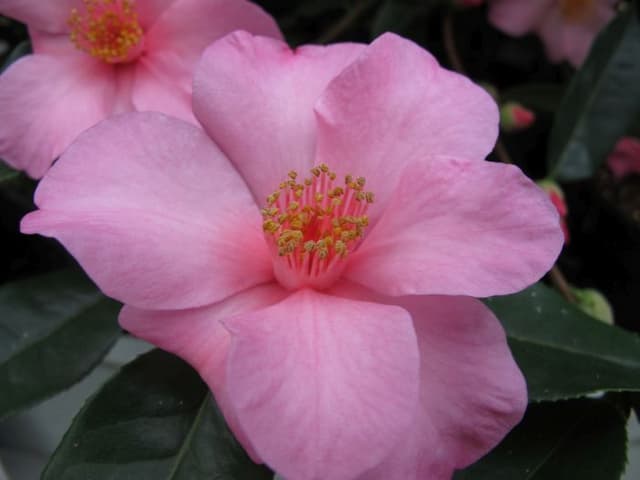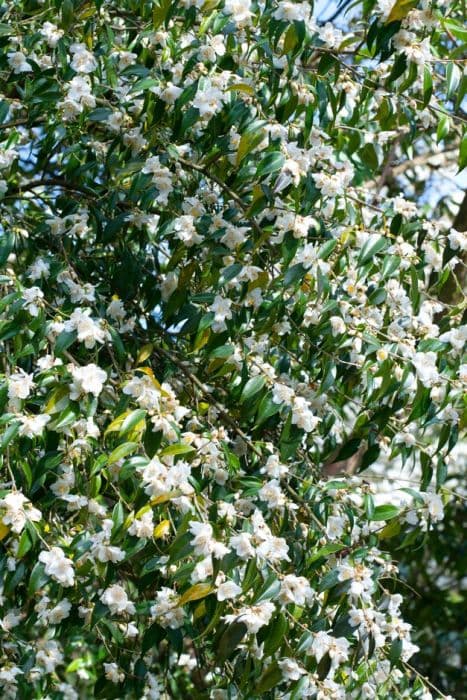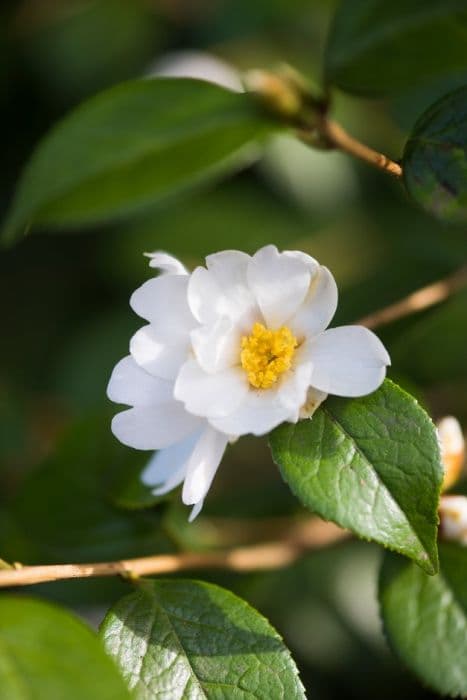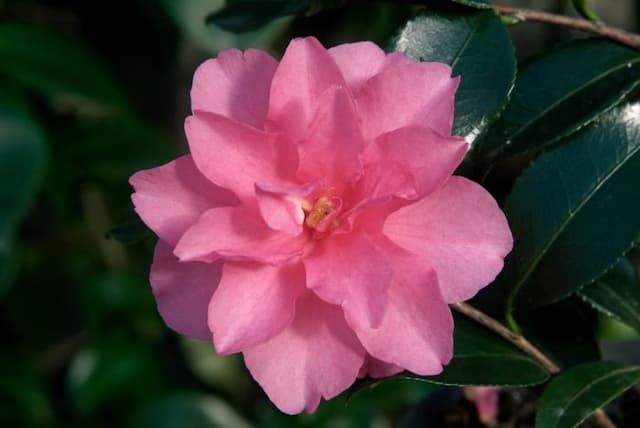Japanese Camellia Camellia japonica 'Grand Prix'

ABOUT
The Camellia japonica 'Grand Prix' is a captivating plant known for its lush, glossy green leaves and its striking flowers which are a hallmark of the species. The leaves are typically oval-shaped with slightly serrated edges and possess a leathery texture that gives them a robust and evergreen appearance throughout the year. As for the flowers, they are undoubtedly the showstoppers of this plant. The 'Grand Prix' is celebrated for its large, peony-like blossoms that bloom in various shades of deep pink to red. These flowers are characterized by multiple layers of delicate, velvety petals that unfurl elegantly from the bud, often revealing a cluster of contrasting yellow stamens at their center. The blooms emit a subtle, pleasing fragrance that can be enjoyed during the flowering season. The overall aspect of Camellia japonica 'Grand Prix' is one of classic beauty and charm, making it a popular choice for ornamental gardening and adding a splash of vibrant color to any landscape.
About this plant
 Names
NamesFamily
Theaceae.
Synonyms
Japanese Camellia, Rose of Winter, Camellia.
Common names
Camellia japonica 'Grand Prix'
 Toxicity
ToxicityTo humans
The Camellia japonica, commonly known as the Japanese camellia, is not considered toxic to humans. There are no well-documented cases of poisoning from ingesting this plant, and it is generally regarded as safe. However, it is always advisable to avoid eating ornamental plants as a precaution, and to seek medical advice if any plant material is consumed in large quantities or if symptoms of illness appear.
To pets
The Camellia japonica, commonly known as the Japanese camellia, is not considered toxic to pets either. Cats, dogs, and other domestic animals can typically coexist with this plant without any risk of poisoning. Nevertheless, it is always best to prevent pets from eating plants, as they could cause gastrointestinal upset or other non-toxic reactions simply due to the ingestion of non-food items. If a pet does ingest a large amount of the plant and shows signs of distress, it is advised to consult a veterinarian.
 Characteristics
CharacteristicsLife cycle
Perennials
Foliage type
Evergreen
Color of leaves
Dark green
Flower color
Red
Height
6-10 feet (1.8-3 meters)
Spread
6-10 feet (1.8-3 meters)
Plant type
Shrub
Hardiness zones
7-9
Native area
Japan
Benefits
 General Benefits
General Benefits- Ornamental Value: Adds visual appeal with its large, peony-like flowers and glossy evergreen foliage, enhancing garden aesthetics.
- Year-Round Interest: Offers evergreen foliage for garden structure and interest even when not in bloom.
- Ease of Care: Requires relatively minimal maintenance once established, making it suitable for various gardeners.
- Versatility in Landscaping: Can be used in a variety of garden settings, including borders, hedges, and as a specimen plant.
- Attracts Pollinators: Blooms provide nectar for bees and other pollinating insects, supporting local ecosystems.
- Long Blooming Period: Flowers from late winter to early spring, providing color during typically bleak months.
- Shade Tolerance: Can grow well in partially shaded conditions, offering flexibility in garden placement.
- Resilience to Pests: Shows resistance to many common garden pests, reducing the need for chemical treatments.
- Wide Range of Cultivars: Comes in a variety of cultivars, allowing for a diverse selection of colors and forms.
- Drought Tolerance: Displays some drought resistance once established, beneficial in regions with water restrictions.
 Medical Properties
Medical PropertiesThis plant is not used for medical purposes.
 Air-purifying Qualities
Air-purifying QualitiesThis plant is not specifically known for air purifying qualities.
 Other Uses
Other Uses- Ink Making: The petals of Camellia japonica can be used to create a natural dye, which can then be formulated into a plant-based ink for art and calligraphy.
- Botanical Jewelry: The flowers and leaves, when dried and preserved, can be incorporated into unique pieces of botanical jewelry like necklaces and earrings.
- Fabric Dye: Similar to ink, the blossoms can be used to dye fabrics, offering a range of pink to red hues, depending on the mordant used.
- Baking Decor: Edible flowers from Camellia japonica can be crystallized with sugar and used to decorate cakes and pastries.
- Photography: The flower's striking colors and form make it a favorite subject for photographers practicing botanical and macro photography.
- Fish Tanks: After ensuring that the plant is free from pesticides, leaves from Camellia japonica can be used in fish tanks to provide shelter and a natural environment for fish.
- Companion Planting: Camellias can be planted alongside vegetable gardens to attract pollinators and improve the overall biodiversity of the garden area.
- Traditional Crafts: The flowers and leaves can be used in the art of pressing and preserved in traditional crafts such as bookmarks and greeting cards.
- Ice Cubes Decoration: Petals from the Camellia japonica can be frozen inside ice cubes to create an elegant touch in beverages for special occasions.
- Natural Confetti: Dried petals can be used as an eco-friendly alternative to traditional confetti at celebrations such as weddings.
Interesting Facts
 Feng Shui
Feng ShuiThe Camellia is not used in Feng Shui practice.
 Zodiac Sign Compitability
Zodiac Sign CompitabilityThe Camellia is not used in astrology practice.
 Plant Symbolism
Plant Symbolism- Adoration and Devotion - Camellia japonica 'Grand Prix', also known as the Japanese Camellia, often symbolizes deep adoration and devotion, which can be attributed to its lush, full blooms that represent the fullness of emotion one holds for another.
- Love - The Japanese Camellia is associated with love, possibly connected to its use as a gift in romantic contexts and the fact that it blooms around Valentine's Day in some regions, making it a seasonal symbol of affection.
- Longevity and Perseverance - The Camellia's ability to thrive for many years and bloom during the cold winter months denotes longevity and perseverance, suggesting a resilience and steadfastness in both life and relationships.
- Beauty - With its strikingly beautiful petals and vibrant colors, Camellia japonica 'Grand Prix' is often associated with beauty, perfection, and refinement.
- Recognition - Giving someone a Camellia japonica 'Grand Prix' can also symbolize recognition or admiration for their accomplishments, as the flower stands out and commands attention with its grandeur.
 Water
WaterThe common camellia should be watered to keep the soil consistently moist but never waterlogged. During active growth, especially in dry spells, water thoroughly once a week using about 1-2 gallons per watering for an established plant. Reduce watering in winter, and always water at the base of the plant to avoid wetting the foliage, which can lead to disease.
 Light
LightCamellias prefer dappled shade or morning sun with afternoon shade to protect their foliage and blossoms from harsh direct sunlight. The best spot for a camellia is on the east or north side of a building or under the partial shade of tall trees. Avoid exposure to the hot afternoon sun, especially in southern climates.
 Temperature
TemperatureCamellias thrive in temperatures between 60°F and 80°F. They can survive brief dips to around 20°F but may be damaged by prolonged exposure to temperatures below freezing. Ideal conditions would have cool, stable temperatures that avoid the extremes of heat and cold.
 Pruning
PruningPrune camellias to maintain their shape and to clean out any dead or crossing branches, thus promoting overall plant health. The best time to prune is just after the blooms have faded in spring but before new flower buds form. Pruning is typically done annually or as needed for shaping.
 Cleaning
CleaningAs needed
 Soil
SoilCamellia or Japanese Camellia 'Grand Prix' prefers well-drained, acidic soil with a pH range of 5.5 to 6.5 for optimal growth. A good soil mix can be created by combining equal parts of pine bark, peat moss, and perlite or sand to ensure proper drainage and aeration.
 Repotting
RepottingJapanese Camellia 'Grand Prix' generally needs to be repotted every 2-3 years or when it becomes root-bound, typically evident by roots growing out of the drainage holes or the soil drying out rapidly.
 Humidity & Misting
Humidity & MistingJapanese Camellia 'Grand Prix' thrives best in moderate to high humidity levels, ideally between 50-80%. It benefits from regular misting or placement near a humidity tray.
 Suitable locations
Suitable locationsIndoor
Place in bright, indirect light; keep soil moist.
Outdoor
Partial shade, shield from direct afternoon sun.
Hardiness zone
7-9 USDA
 Life cycle
Life cycleCamellia japonica 'Grand Prix', commonly known as the Japanese camellia, begins its life as a seed that germinates in moist, well-drained soil, preferably in partial shade. After germination, it enters a seedling stage where it develops its root system and first set of true leaves. The plant then enters a juvenile phase, establishing itself over several years, growing steadily and producing more substantial foliage. Once mature, usually after a few years, it enters the flowering stage, producing large, showy flowers typically in late winter to early spring. After pollination, which is often aided by insects, the plant produces seed pods that ripen by autumn, completing the reproductive cycle. Throughout its life, the Japanese camellia undergoes seasonal cycles of growth and dormancy, responding to environmental cues of temperature and light.
 Propogation
PropogationPropogation time
Spring-Early Summer
The Camellia japonica 'Grand Prix', commonly known as the Japanese Camellia, is most commonly propagated by semi-hardwood cuttings. This method involves taking cuttings from the current year's growth during the late summer or early fall when the stems have partially matured. The ideal cutting is about 4 to 6 inches (approximately 10 to 15 centimeters) long and contains several leaves. The bottom inch of the cutting is stripped of leaves and dipped in a rooting hormone to encourage root development. This treated end is then inserted into a mix of moistened soil and perlite or vermiculite and placed under conditions with indirect light and high humidity. Roots typically develop within several weeks, after which the new plants can be gradually acclimated to less humid conditions before being planted in a more permanent location.









